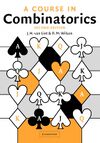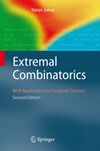组合数学 (Spring 2024): Difference between revisions
Jump to navigation
Jump to search
| Line 172: | Line 172: | ||
** [https://en.wikipedia.org/wiki/Vapnik%E2%80%93Chervonenkis_dimension Vapnik–Chervonenkis dimension] | ** [https://en.wikipedia.org/wiki/Vapnik%E2%80%93Chervonenkis_dimension Vapnik–Chervonenkis dimension] | ||
* [https://en.wikipedia.org/wiki/Kruskal%E2%80%93Katona_theorem Kruskal–Katona theorem] | * [https://en.wikipedia.org/wiki/Kruskal%E2%80%93Katona_theorem Kruskal–Katona theorem] | ||
* [http://en.wikipedia.org/wiki/Ramsey_theory Ramsey theory] | |||
:*[http://en.wikipedia.org/wiki/Ramsey's_theorem Ramsey's theorem] | |||
:*[http://en.wikipedia.org/wiki/Happy_Ending_problem Happy Ending problem] | |||
:*[https://en.wikipedia.org/wiki/Van_der_Waerden%27s_theorem Van der Waerden's theorem] | |||
:*[https://en.wikipedia.org/wiki/Hales%E2%80%93Jewett_theorem Hales–Jewett theorem] | |||
* [https://en.wikipedia.org/wiki/Hall%27s_marriage_theorem Hall's theorem ] (the marriage theorem) | |||
:* [https://en.wikipedia.org/wiki/Doubly_stochastic_matrix Birkhoff–Von Neumann theorem] | |||
* [http://en.wikipedia.org/wiki/K%C3%B6nig's_theorem_(graph_theory) König-Egerváry theorem] | |||
* [http://en.wikipedia.org/wiki/Dilworth's_theorem Dilworth's theorem] | |||
:* [http://en.wikipedia.org/wiki/Erd%C5%91s%E2%80%93Szekeres_theorem Erdős–Szekeres theorem] | |||
* The [http://en.wikipedia.org/wiki/Max-flow_min-cut_theorem Max-Flow Min-Cut Theorem] | |||
:* [https://en.wikipedia.org/wiki/Menger%27s_theorem Menger's theorem] | |||
:* [http://en.wikipedia.org/wiki/Maximum_flow_problem Maximum flow] | |||
* [https://en.wikipedia.org/wiki/Linear_programming Linear programming] | |||
** [https://en.wikipedia.org/wiki/Dual_linear_program Duality] | |||
** [https://en.wikipedia.org/wiki/Unimodular_matrix Unimodularity] | |||
* [https://en.wikipedia.org/wiki/Matroid Matroid] | |||
Revision as of 12:33, 29 May 2024
This is the webpage for the Combinatorics class of Spring 2024. Students who take this class should check this page periodically for content updates and new announcements.
Announcement
- (2024/03/19) 第一次作业已发布,请在 2024/04/03 上课之前提交到 njucomb24@163.com (文件名为'学号_姓名_A1.pdf').
- (2024/04/10) 第二次作业已发布,请在 2024/04/24 上课之前提交到 njucomb24@163.com (文件名为'学号_姓名_A2.pdf').
- (2024/05/15) 第三次作业已发布,请在 2024/05/29 上课之前提交到 njucomb24@163.com (文件名为'学号_姓名_A3.pdf').
Course info
- Instructor : 尹一通 (homepage)
- email: yinyt@nju.edu.cn
- office: 计算机系 804
- Teaching assistant:
- Class meeting: Wednesday, 2pm-4pm, 仙Ⅱ-211.
- Office hour: TBA
- QQ群: 709281027 (加入时需报姓名、专业、学号)
Syllabus
先修课程 Prerequisites
- 离散数学(Discrete Mathematics)
- 线性代数(Linear Algebra)
- 概率论(Probability Theory)
Course materials
成绩 Grades
- 课程成绩:本课程将会有若干次作业和一次期末考试。最终成绩将由平时作业成绩 (≥ 60%) 和期末考试成绩 (≤ 40%) 综合得出。
- 迟交:如果有特殊的理由,无法按时完成作业,请提前联系授课老师,给出正当理由。否则迟交的作业将不被接受。
学术诚信 Academic Integrity
学术诚信是所有从事学术活动的学生和学者最基本的职业道德底线,本课程将不遗余力的维护学术诚信规范,违反这一底线的行为将不会被容忍。
作业完成的原则:署你名字的工作必须是你个人的贡献。在完成作业的过程中,允许讨论,前提是讨论的所有参与者均处于同等完成度。但关键想法的执行、以及作业文本的写作必须独立完成,并在作业中致谢(acknowledge)所有参与讨论的人。不允许其他任何形式的合作——尤其是与已经完成作业的同学“讨论”。
本课程将对剽窃行为采取零容忍的态度。在完成作业过程中,对他人工作(出版物、互联网资料、其他人的作业等)直接的文本抄袭和对关键思想、关键元素的抄袭,按照 ACM Policy on Plagiarism的解释,都将视为剽窃。剽窃者成绩将被取消。如果发现互相抄袭行为, 抄袭和被抄袭双方的成绩都将被取消。因此请主动防止自己的作业被他人抄袭。
学术诚信影响学生个人的品行,也关乎整个教育系统的正常运转。为了一点分数而做出学术不端的行为,不仅使自己沦为一个欺骗者,也使他人的诚实努力失去意义。让我们一起努力维护一个诚信的环境。
Assignments
Lecture Notes
- Basic enumeration | 基本计数 (slides)
- Generating functions | 生成函数 (slides)
- Sieve methods | 筛法 (slides)
- Pólya's theory of counting | Pólya计数法 (slides)
- Cayley's formula | Cayley公式 (slides)
- Existence problems | 存在性问题 (slides)
- The probabilistic method | 概率法 (slides)
- Extremal graph theory | 极值图论 (slides)
- Extremal set theory | 极值集合论(slides)
- Old and new proofs of the Erdős–Ko–Rado theorem by Frankl and Graham
- Improved bounds for the sunflower lemma by Alweiss-Lovet-Wu-Zhang and a simplified proof by Rao
- Ramsey theory | Ramsey理论(slides)
Resources
- Combinatorics course by Jacob Fox
- Probabilistic Methods in Combinatorics and Graph Theory and Additive Combinatorics by Yufei Zhao
- Combinatorics Lecture Videos online
- Collection of Combinatorics Videos
Concepts
- Binomial coefficient
- The twelvefold way
- Composition of a number
- Multiset
- Combinations with repetition, [math]\displaystyle{ k }[/math]-multisets on a set
- Multinomial coefficients
- Stirling number of the second kind
- Partition of a number
- Fibonacci number
- Catalan number
- Generating function and formal power series
- Newton's formula
- The principle of inclusion-exclusion (and more generally the sieve method)
- Möbius inversion formula
- Derangement, and Problème des ménages
- Ryser's formula
- Euler totient function
- Burnside's lemma
- Pólya enumeration theorem
- Cayley's formula
- Double counting and the handshaking lemma
- Sperner's lemma and Brouwer fixed point theorem
- Pigeonhole principle
- The Probabilistic Method
- Lovász local lemma
- Erdős–Rényi model for random graphs
- Extremal graph theory
- Turán's theorem, Turán graph
- Two analytic inequalities:
- Erdős–Stone theorem (fundamental theorem of extremal graph theory)
- Sunflower lemma and conjecture
- Erdős–Ko–Rado theorem
- Sperner's theorem
- Sperner system or antichain
- Sauer–Shelah lemma
- Kruskal–Katona theorem
- Ramsey theory
- Hall's theorem (the marriage theorem)

